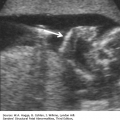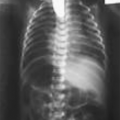Definition Monoamniotic (MA) twins share a common amniotic sac. Triplets and higher-order multifetal gestations also may contain a monochorionic (MC) twin pair. The most severe form of MA twins is conjoined (CJ) twins, which are defined by the shared body region (“pagus”), and can be dorsally (more common) or ventrally conjoined.
Incidence The reported incidence of MA twinning ranges from 1 in 1650 to 1 in 93,734 live births. Up to 20% of higher-order multifetal gestations can contain a MC pair. CJ twins are the rarest MC complication, occurring at an approximate rate of 10.25 per million births.
Embryology MA and CJ twins are at the last part of a spectrum of incomplete cleavage. Discordant anomalies occur more commonly in MC gestations (6% to 8%).
There are several proposed mechanisms for the increased incidence of structural anomalies in MC twins, including teratogenicity of zygotic splitting and vascular “accidents.” Because of their unique angioarchitecture, MC twins have a higher incidence of morbidity and mortality than dichorionic (DC) twins. This is likely due to the sharing of a single placenta and the vascular communications that exist between twins. Loss of one twin can result in death (~15%) or significant neurologic injury (~30%) in the surviving twin. The suspected mechanism is pressure and volume shifts that occur at the time of death of one twin: the surviving twin exsanguinates into the demised twin.
Inheritance Patterns Inheritance is sporadic.
Teratogenesis None are known.
Prognosis The prognosis for MA twins is largely related to the presence of congenital malformations and the gestational age at delivery. Multifetal MC gestations are at a high risk for pregnancy complications and invariably result in preterm birth, either iatrogenic or spontaneous. Only 18% of prenatally diagnosed CJ twins survive.
MA twins are suspected when an intertwin membrane cannot be identified in association with other sonographic stigmata of an MC gestation.
Single placental mass
Concordant gender
Documenting cord entanglement confirms the diagnosis.
Other complications of MC gestations can occur within a MA gestation.
Twin-twin transfusion syndrome (TTTS)
Selective fetal growth restriction (sFGR)
Twin anemia-polycythemia sequence (TAPS)
Discordant anomalies
Some major structural anomalies, such as anencephaly and lower urinary tract obstruction, can be reliably detected in the late first trimester.
Chorionicity in high-order multifetal gestations is best determined in the first trimester.
The diagnosis of CJ twins is relatively straightforward.
No intervening amniotic fluid
Single umbilical cord with more than three vessels
Persistence of heads at the same body plane
Lack of separation of fetuses over time
Defining the degree of conjoining can be challenging and may require high-resolution two-dimensional ultrasound, three-dimensional ultrasound, color Doppler mapping, magnetic resonance imaging (MRI), and fetal echocardiography.
Twin-twin transfusion syndrome
Preterm premature rupture of one sac
Selective fetal growth restriction
Bilateral renal agenesis in one fetus
Investigations and Consults Required Multidisciplinary collaboration and prenatal consultation are essential in developing a newborn management plan. The services involved will depend on the nature of the structural anomalies identified.
Monitoring MA twins typically undergo intensive antenatal surveillance beginning at the point of viability, as either inpatients or outpatients, until delivery, typically at 32 weeks. MC gestations discordant for anomalies and multifetal MC gestations that are not reduced should be monitored intensively, especially after the point of viability. Those that are reduced can be offered more routine surveillance, as the risk of acute twin-twin exsanguination is eliminated by cord coagulation.
Fetal Intervention MA twin gestations discordant for major anomalies may be candidates for selective termination of the anomalous fetus as a means of pregnancy prolongation for the healthy co-twin. Cord transection after occlusion is recommended to avoid cord accident. Consideration should be given to reduction of the MC pair of a high-order MC gestation as these pregnancies are at a high risk for complications and preterm birth. Unlike other circumstances of selective termination in MC gestations where cord occlusion is required, multifetal pregnancy reduction of the MC pair can be performed using standard techniques of injection of cardioplegic medications under ultrasound guidance and should be performed in the late first trimester.
Pregnancy Termination Issues Selective feticide in MC gestations must be performed by a cord occlusive technique, as cardioplegic medications can pass from one twin to the other through patent vascular channels.
Delivery Delivery should occur in a tertiary center because of the high risk of prematurity. Because of the risk of cord entanglement, MA twins are generally delivered by cesarean section. Gestational age, the patient’s wishes regarding neonatal management, and the risk of maternal harm must be weighed when considering route of delivery for CJ twins.
Resuscitation Anticipate difficulty with spontaneous onset of respiration, as well as problems associated with preterm delivery.
Transport Transfer to a tertiary center for neonatal intensive care is necessary in the majority of cases. Respiratory assistance, as well as support of myocardial function with continuous infusion of inotropic medication, may be required during transport.
Nursery Management Respiratory support, relief of myocardial stress, reduction of congestive heart failure, and correction of perinatal asphyxia are usually needed; thus, it is necessary to institute measures to accomplish these goals immediately following birth. Because most twin pregnancies are delivered prematurely, respiratory distress syndrome may also further complicate the clinical course. Early administration of surfactant replacement therapy may hasten the resolution of the latter.
Stay updated, free articles. Join our Telegram channel

Full access? Get Clinical Tree












